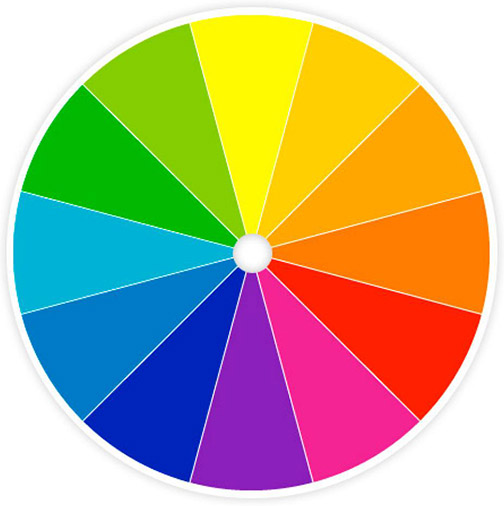
In my last post I talked a bit about how the two color systems, Additive Color and Subtractive Color work and how our eyes physically perceive color. In this post we’ll get down to the fun and helpful part of the color theory discussion: the color wheel and how to use it.
How the color wheel is laid out, is vitally important to its function. The 3 Primary Colors: yellow, red and blue are at 12 o’clock, 4 o’clock and 8 o’clock. They form the Triad of the color wheel. At locations halfway between each of the primary colors, as you work your way around the wheel, are the Secondary Colors: orange, violet and green. Colors that are next to each other on the color wheel are referred to as Analogous Colors, colors directly across from each other are Complementary Colors.
Understanding this information can assist you in establishing Mood in your paintings. For the most harmonious, serene mood in your work use analogous colors, colors next to or near each other on the color wheel. For the most lively color themes in your paintings, utilize complementary or near complimentary colors: colors opposite each other on the color wheel.
Select any color, at any location on the color wheel. Locate the color directly across from it, its Compliment, and realize that the complement is made up of all the colors in the color spectrum that the first color lacks. For example: red’s complement, green, is made up of blue and yellow. Orange’s (red and yellow) complement is blue. When you abut pure complements of identical value against each other, the two colors are so lively they’ll create a color vibration producing an optical illusion in your eye of a third color along their adjoining sides.
Too often, I’ve seen painters using black to darken their paints. Black paints are made from charcoal. So adding black to darken your colors is kinda’ like adding a charcoal briquette to your color. It makes your colors dirty. Since the world is lit by a spectrum of colored light (remember the discussion of the Additive Color spectrum in my last blog) there is color even in shadows. They’re really not black. A better solution, than using black, is to bring the value of your colors down by adding a dark version of the compliment or a near compliment. Using the complimentary color is also the best way to mute colors that are too bright for your purpose. The muted colors and grays you create are scrumptious (did I just say scrumptious?)!


If you must use black and you’re working with oils, at least take a look at the new black, Chromatic Black, created by Gamblin Artists Colors. They avoided charcoal and instead mixed very dark versions of Phthalo Green and its compliment Alizarin Crimson to create a black. So you may still be using black, but you’ll be working with color not charcoal.
And here’s probably the most important thing the color wheel can assist you with. Ever stand there pondering your subject matter, whether an old barn on location or a live model in the studio and ask yourself, “What the hell IS that color in the shadow?” We’ve all been there, many times! Determine the color of lit area of your subject and know the shadow is going to be some value of its compliment. Colored light casts a complimentary colored shadow. Doubt this? Grab a light source, a colored piece of cellophane, a white card and an egg and find yourself a dark room. Point your light wrapped in the colored cellophane at the egg resting on the white card. The shadow cast will be a brilliant version of the cellophane’s complimentary color.
Add a color wheel to your paintbox. Use it religiously and in no time you will have it committed to memory. The colors in your paintings will be become cleaner and more lively!
